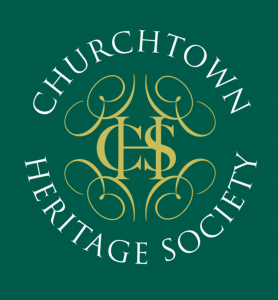THE REBUILDING OF CHURCHTOWN VILLAGE
By Jim McCarthy
In the years following the attack and the burning in 1822, Sir Edward Tierney, agent to Lord Egmont, the landlord, cleared away all the thatched houses and rebuilt the village in the form it is in today. Samuel Lewis reporting on the state of the village in the year 1837 says the village contains several neat slated houses, a good inn and a constabulary police station. A court for the Manor of Burton, which includes several parishes is held once in three weeks, in which debts not exceeding forty shillings are recoverable. In the year 1849 the village of Churchtown was completed.
The new Catholic Church was built in 1839. A fine market house was built in 1845 and the school was built in 1846. The village had two fine hand water pumps. One of those pumps was on the opposite side of the road from the school and a large iron cup was chained to it. Here generations of boys and girls drank the crystal water from that old cup. I have never since tasted water that could equal that which came from the old pump beside the old school in Churchtown village.
The village was built in the form of a triangle, one side of it was named Egmont Row. The main street of the village was named George’s Street and that running west was named Kerry Lane. The double row of houses on the Buttevant road was named Chapel Lane and the road leading in the direction of Ballyhea was named Lodge Road. How this road got its name was because the great castellated entrance to Burton Park stood on this road about a hundred and fifty yards from the village. At the northern end of George’s St. are the entrance gates and lodge to Churchtown House. About three hundred yards to the west of the village at a place called Maryfield, stood the Church of Ireland, Parish Church (now demolished ).
In the year of 1910, the population of Churchtown village was two hundred and ten and at that time the village had four public houses, a post office, a police station, two bakeries, Flannery’s and O’Briens.
CHURCHTOWN CREAMERY
Churchtown creamery was built in the year 1889. It was owned and worked by a number of farmers known as the Churchtown Creamery Co. In those far off days the amount of milk taken in daily amounted to 3,000 gallons. In its early years it had many difficulties to contend with and for a time and more than once it was in danger of closing. However, it weathered the storm and proved to be one of the most successful creameries in the South of Ireland. During my schooldays, it was a busy place as we passed by it each morning. Hundreds of horse, pony and ass carts lined the road for a quarter of a mile on each side of the creamery gates. The manager I remember well, His name was Peter Curtin. Mark Tracy was the buttermaker who made that lovely butter which was sold all over the British Isles under the brand name “Lily”. Patsy Connors was the engine man and Tom Tracy, brother to Mark, gave out the skim milk. All those lovely characters have long since passed to their happy home beyond the great divide. Churchtown Creamery later became part of Ballyclough who turned it into a collection point.
THE OLD SCHOOL
The old school in the village of Churchtown which I mentioned earlier, the place where I first learned to read and write, was built in the year 1846. It was then a part of the new village being rebuilt by Sir Edward Tierney. It was a solid two storey cut stone building capable of accommodating two hundred children. A clause in the Deed of Assignment states that the principal teachers ( both male and female ) were to receive a sum of £5 annually to teach the children of the parish. The male teacher was also to receive an additional sum of £5 for his services in assisting the agent to collect the rents of the Earl of Egmont. This sum was paid annually until the sale of the estates in the year 1887.




